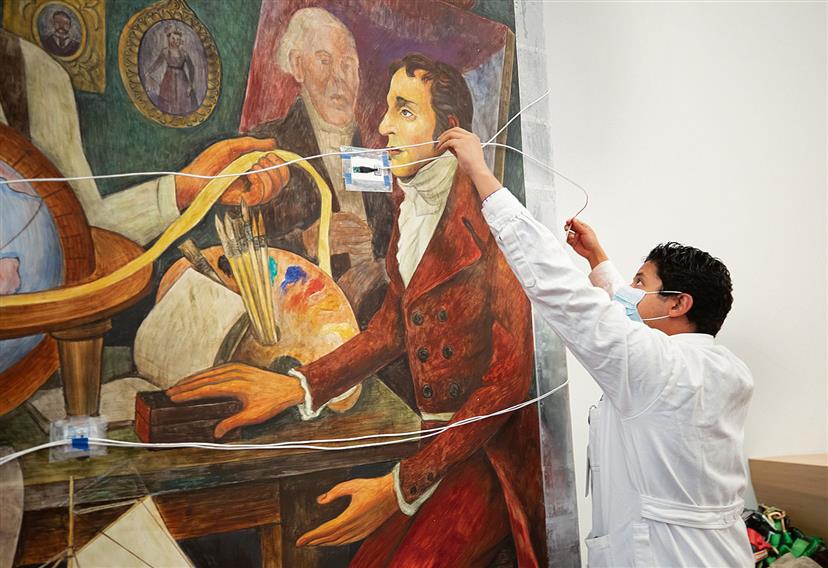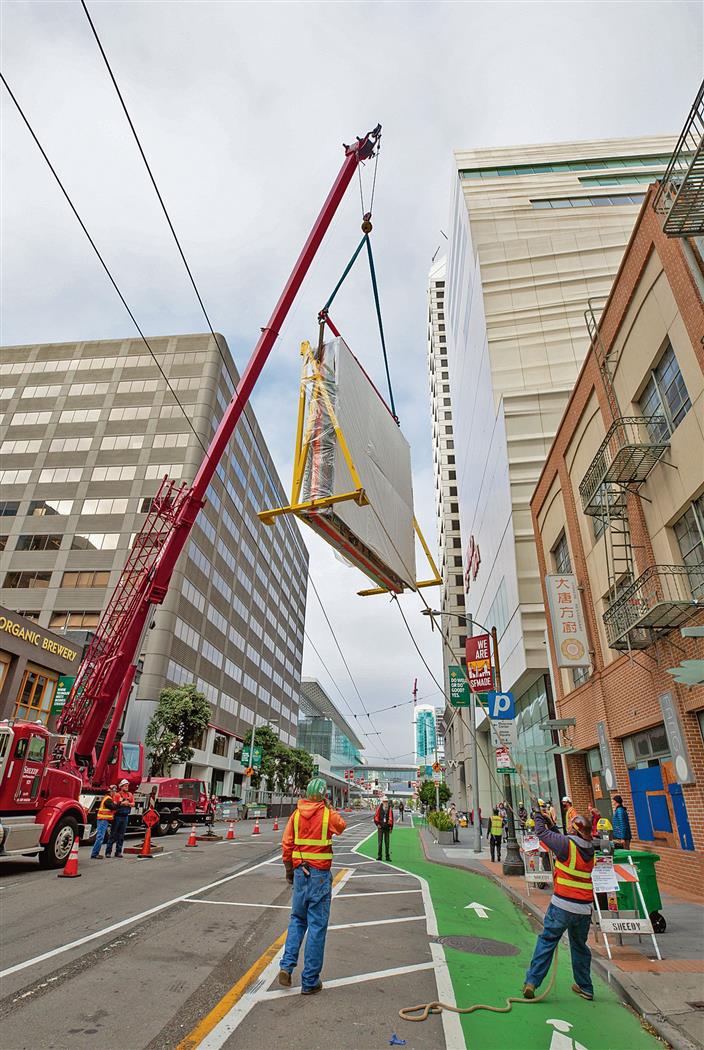
A full view of the mural by Diego Rivera. Images courtesy: San Francisco Museum of Modern Art
BN Goswamy
My mural will picture the fusion between the great past of the Latin American lands, as it is deeply rooted in the soil, and the high mechanical developments of the United States… What I am painting now: it is about the marriage of the artistic expression of the North and of the South on the continent, that is all. I believe in order to make an American art, a real American art, this will be necessary, this blending of the art of the (American) Indian, the Mexican, the Eskimo…
Diego River, on his 1940 mural, Pan American Unity
This is one of the most ambitious things this museum has ever done — to move something this large, this fragile and this important. It was like moving a ‘70-foot eggshell’, as a colleague described the process of re-location.
Neal Benezra, director of the San Francisco Museum on bringing Rivera’s mural to the Museum
Less than a month back, a work of art was thrown open to the public at the San Francisco Museum of Modern Art. Works of art are always being thrown open to the public by museums, one could say, but this was no ordinary work. It was a monumental mural — 30 tons in weight, 74x22 feet in size, and made up of five enormous panels, each bursting with energy — painted some 80 years ago by one of the most famous, most iconic of Mexican painters: Diego Rivera (1886-1957). And it is not as if the mural — popularly, although not originally, titled Pan American Unity — had just been bought by the Museum: it was only being moved to its new location from another part of the city. It had always been there: since 1940, in fact, in the City College of Fine Arts where Rivera had painted it. But now the city authorities wanted it to be more accessible than it was in a small college. The decision was taken some four years back, the time it was to take for moving the mural, but also with the knowledge that it would cost the city several million dollars while engaging a host of ‘engineers, architects, art historians, art handlers and riggers’, all from the United States and Mexico.

There was an air of celebration in San Francisco when the mural was first painted. At that time, Rivera was at the height of his powers; for the city it was wonderful for this man, an elemental creative force that he was, to have produced this masterful work in, and for, it. And there is an air of celebration in the city now, not only because the work is at long last open to viewing by masses of people inside a celebrated museum, but also because its re-location — a massive and very expensive undertaking — was completed without even a trace of hitch or loss. One can understand the jubilation, for the work is truly remarkable: pulsating as it does with energy, crowded with numberless figures who come into it from times past and present and future and fill its spaces, reflecting the artist’s grand vision of fusion — “from the south comes the plumed serpent, from the north the conveyor belt”, in his words. The eye can hardly take in all that it contains. There, presiding over everything is the ancient, looming Aztec goddess of earth, Coatlicue. In another segment are crowds of people looking up, craning their necks, to see artists carve a mammoth animal that appears to have just landed on the earth from the sea. Heroes, as much as villains, of past and present beam down — Simon Bolivar and Thomas Jefferson, Hitler and Stalin, Charlie Chaplin and Paulette Goddard — and then Diego Rivera himself, with his wife, the iconic Frida Kahlo, in the neighbourhood, makes an appearance. Everywhere that one looks, there are potters and sculptors, tinsmiths and grass-cutters, wood-carvers and weavers, peasants and basket-makers. It is a dizzying kaleidoscope but there are no accidental shapes or forms here: everything makes sense, everything falls like pieces in the puzzle of a soaring imagination.
This, however, is only one part of the scene, the happening: the other was how to move the monumental object. There are elaborate descriptions, even for the common man, of the preparations that went into the enterprise and of the actual execution of it. Each part of the process was thought out in advance to move the panels to the museum. One early trip involved a special truck holding one ‘pseudo-panel’ encased with custom-made shock absorbers riding at 5 miles per hour across town. Engineers and designers from the University and the Design Centre, including Professor Reivich, were commissioned. Knowing that the biggest threat to the fresco — which had not directly been painted on the wall, but on plastered panels which could be removed but with the greatest caution, delicately — were vibrations, the team tested mock-ups. Nearly exact replicas of two panels, using the materials that Rivera had used, were prepared: a wall was built placing bolts and welding in the same locations as in the original fresco. Tools were experimented with to determine how to extract panels with minimal vibrations. ‘Then they shook, bent, and hammered them,’ Dr Reivich wrote, ‘to learn the maximum resistance they could support.’ 18-inch-wide Swiss cheese-like holes in the exterior walls of the College were drilled. The notes go on: ‘Threaded rods were slowly twisted into place above and below the mural by teams of movers situated inside and outside the building, who wore headsets to synchronise their actions as they simultaneously turned the rods — one-sixteenth of an inch at a time. It took two hours for one panel to move six inches.’
This is the way it went.
Will it go anything like this here, in our land, where there are disturbing plans to move all objects in the National Museum — and the National Archives — to a new location as a part of the Central Vista project? Or will it be an affair of bubble-wraps and incomplete inventories, and out of job, untrained men hired to move great national treasures?

Join Whatsapp Channel of The Tribune for latest updates.



























